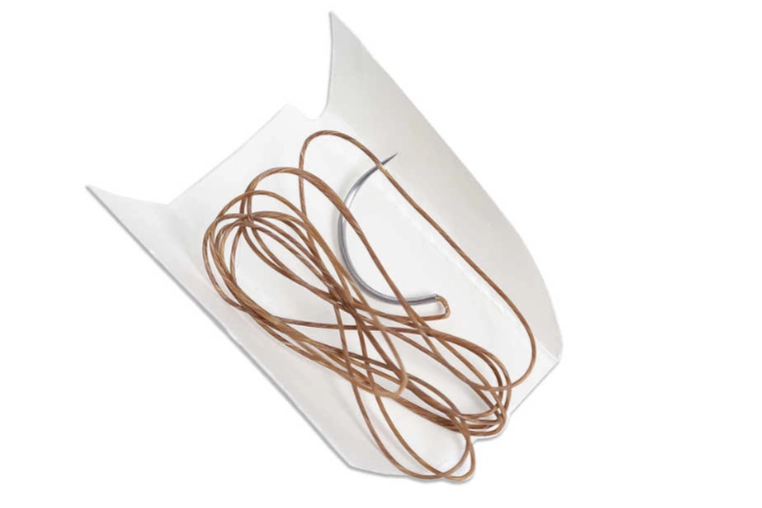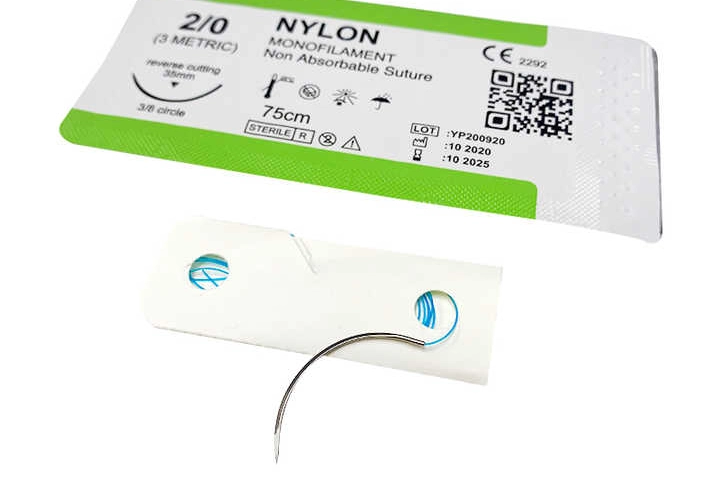
Classification of Sutures by Material
Natural Sutures
Organic materials like animal tissues are employed to manufacture medical sutures to be applied in surgical procedures—a procedure in place for decades now due to the compatibility of body tissues with the simplicity of application during operations. Traditional examples are silk and cat gut sutures; Silk sutures consist of threads that are well known for possessing good knot security and tensile strength; while cat gut sutures made of sheep or cow intestines are absorbable and ideal, to close up inside tissues.
Synthetic Sutures
Synthetic operating stitches are made from artificial materials such as nylon or polyester and even polyglycolic acid (PGA). Synthetic stitches ensure quality and have predetermined absorption rates that can be accurately predicted. Both absorbable and nonabsorbable types are present to meet surgical requirements. Synthetic absorbable sutures such as PGA or polylactic co-glycolic acid (PLGA) break down through hydrolysis which allows controlled absorption and reduces the likelihood, of tissue reactions.
Absorbable vs Non-Absorbable Sutures
Characteristics of Absorbable Sutures
Absorbable stitches are created to dissolve inside the body gradually without requiring extraction. They are frequently utilized in surgeries where removing stitches is impractical. The breakdown can happen either through enzymes (in absorbable stitches such as catgut or hydrolysis (in synthetic choices like PGA). These stitches work well for tissues that heal rapidly like the system or layers, beneath the skin.
Features of Non-Absorbable Sutures
Non-dissolving sutures are kept inside the body until they are removed manually. They are employed in surgeries where permanent tissue support is needed like in cardiac surgery or bone repair procedures. Nylon, polypropylene, and stainless steel are some of the examples of this type. Nonabsorbable stitches offer resistance to tension and cause a minimal reaction, with tissues yet their removal needs to be done with care to prevent issues.
Monofilament vs Multifilament Sutures
Advantages and Disadvantages of Monofilament Sutures
Monofilament stitches are made from one thread-like material that moves smoothly through tissues without much resistance. This is done to decrease the chances of infection since there are no grooves for bacteria to enter through. The disadvantage, however, is that monofilament sutures are difficult to manipulate since they are stiff and will hold their shape. These are the polypropylene and nylon monofilaments.
Benefits and Limitations of Multifilament Sutures
Multifilament sutures consist of strands twisted or braided together to offer better flexibility and knot security than monofilaments do so. Their textured surface improves handling grip. This may raise concerns about tissue friction and vulnerability, to bacterial buildup if not appropriately coated Silk and polyester are popular multifilament materials employed in different surgical procedures.
Various types of stitches are essential for achieving results, in different medical procedures. They help medical professionals make choices based on the composition of materials used and how well they are absorbed or structured in different clinical situations.
Specialized Suture Types for Specific Applications
Cardiovascular Sutures
Cardiac surgeries need sutures with strength, tissue – compatibility and minimal long – term adverse reactions. Nonabsorbable polypropylene or polyester are used for robustness. Monofilament cuts clot risk. Absorbable PCO serves for temporary support.
Orthopedic Sutures
In bone and joint operations, medical threads play crucial roles. Surgeons often use steel wires crafted from surgical – grade steel to fix fractured bones. These metal threads are highly durable and strong. They are ideal for maintaining the stability of skeletal structures during the recovery process.
For mending damaged soft tissues like tendons, braided polyester threads have become popular choices. These multi-strand synthetic materials provide secure knot-holding capacity that’s vital in demanding orthopedic repairs.
The selection process for medical threads isn’t one-size-fits-all. Operating teams carefully consider two key factors: the specific nature of the procedure being performed and the biological healing process required by the affected body tissue. Each surgical scenario demands tailored solutions – whether reinforcing bone fragments or reconstructing connective tissues, the thread characteristics must align perfectly with the body’s natural repair mechanisms.
Ophthalmic Sutures
Eye operations demand the utilization of delicate sutures in order to reduce scarring and promote accuracy. Single – strand polypropylene or nylon sutures are often chosen because they can easily pass through delicate eye tissues. These sutures are tough. They also lower the chance of tissue reactions. So, they are appropriate for the repair of the cornea or sclera.
In eye surgeries, absorbable substances such as polyglactin 910 can be used. This eliminates the need to remove the sutures.
Factors to Consider When Choosing a Suture Type
Tissue Healing Time and Compatibility
Healing time of the tissue is one important consideration for determining the nature of suture material to use. Such soft tissues with fast healing times as found in subcutaneous layers prefer absorbable sutures that will dissolve over time within the body naturally. Tissues with slow healing like tendons or blood vessels will generally require nonabsorbable sutures for them to keep their form, long-term.
Tensile Strength and Knot Security
Ensuring stitches can handle healing pressures is key for lasting integrity. At the same time, keeping knots firmly locked helps avoid dangerous wound reopening or separation. Braided thread types naturally hold knots better due to their woven structure. Meanwhile, single-strand stitches maintain pulling resistance longer and glide through tissues more smoothly.
Risk of Infection and Patient Sensitivity
When selecting stitching materials for surgeries, infection risks must be thoroughly evaluated. Single-strand stitches carry lower bacterial growth risks than woven types due to their smoother surfaces. Patients’ potential reactions to materials also need consideration—natural options like collagen-based threads might trigger immune responses in some people.
The Advantages of Medco’s Suture Products

Superior Quality Materials
Medco’s dedication to utilizing high-quality material guarantees that its products adhere to surgical guidelines providing a range of natural and synthetic options customized to various medical requirements ultimately reducing risks and improving patient results.
Wide Range of Options for Diverse Surgical Needs
Medco offers an array of suture options tailored to diverse needs. Ranging from absorbable synthetic materials like polyglycolic acid to nonabsorbable choices such, as polypropylene. To accommodate various clinical situations effectively.
Enhanced Performance and Reliability
Medco’s suture products are designed to perform and stay reliable even in challenging situations. The company’s commitment to providing notch surgical solutions is evident in features like steady absorption rates for synthetic absorbable sutures and strong knot security in multifilament options.
FAQ
Q: What are the key drivers for growth in the absorbable suture market?
A: The global absorbable suture market is projected to grow at a 7% CAGR, driven by:
Rising demand for minimally invasive surgeries and aesthetic procedures (e.g., PDO barbed sutures in cosmetic surgeries).
Advancements in bioengineered materials (e.g., antimicrobial coatings, nano-composite sutures) enhancing infection resistance and wound healing.
Aging populations increasing demand for ophthalmic and orthopedic surgeries.
Q: How are synthetic sutures outperforming traditional natural options?
A: Synthetic sutures (e.g., PLGA, PCL, PDO) dominate due to:
Controlled degradation rates: Tailored for specific procedures (e.g., faster absorption in dermatology vs. slower in orthopedic repairs).
Reduced tissue reaction: Synthetic materials like Vicryl Plus (Ethicon) minimize inflammation compared to natural silk or catgut.
Market share: Synthetic sutures account for >80% of ophthalmic and general surgical applications.




